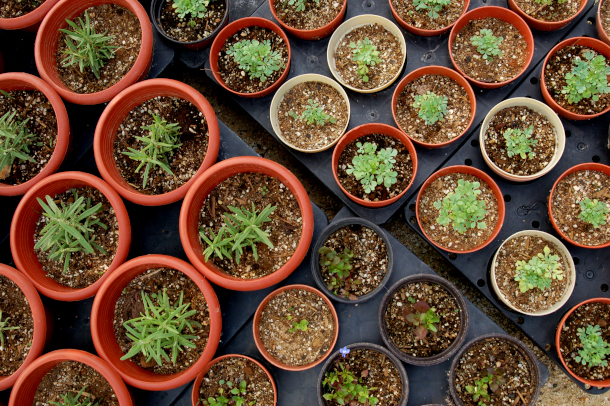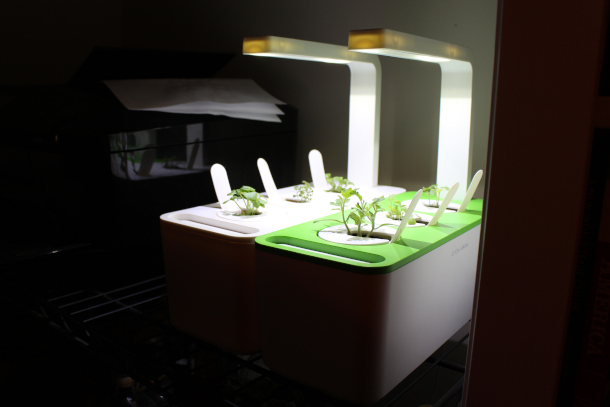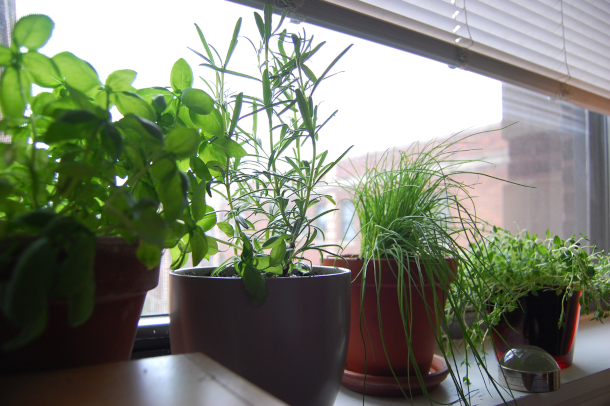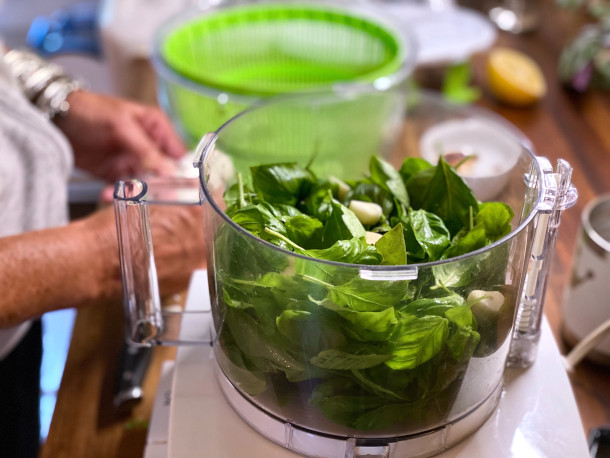Tips for a Thriving Indoor Herb Garden
Air Date: Week of September 22, 2023

If you keep an outdoor herb garden, fall is the perfect time to bring your plants indoors for the winter. (Photo: YoungDoo M. Carey, Flickr, CC BY-NC 2.0)
No matter how cold your winters get, with a bit of counterspace and some windows you can easily grow fresh herbs all year-round inside. Living on Earth’s gardening guru, Michael Weishan joins Host Jenni Doering to share some tips on how to keep up your green thumb indoors.
Transcript
DOERING: The growing season is winding down for many gardeners in northern latitudes. But no matter how cold your winters get, with a bit of counterspace and some windows you can easily grow fresh herbs all year-round inside. Living on Earth’s gardening guru, Michael Weishan has some tips on how to keep up your green thumb indoors. Michael, welcome back to Living on Earth!
WEISHAN: It is a real pleasure to be back.
DOERING: So let's say somebody is starting completely from scratch wanting to grow a nice herb garden indoors. How would you recommend they start it up?
WEISHAN: Well, certain herbs grow much better indoors than others: simple herbs like basil, and sage, and thyme. Things that you can grow easily outdoors, you can probably grow fairly easily indoors. So I would start with the old standbys. Rosemary. The easiest way to do that is actually to buy a small plant, you can even use the ones you see at the grocery store. Oftentimes, they'll have fresh herbs that are actually in a pot, and you know, wrapped in plastic, and you can take that home and adopt it, and grow it on as opposed to just eating it right away. And then you'll, then you'll have something of a harvest later.
DOERING: You know, I have tried to grow rosemary inside, you know, when I bring it indoors for the winter, and ultimately, it always just dies on me. So what do you think I'm doing wrong there?
WEISHAN: Well, there are two real problems: the humidity and also insufficient light in the winter. So the real key to success of growing herbs indoors is to grow them under artificial light. That way, they stay compact, they grow pretty much all year round. You know, they don't get leggy as they reach towards the sun. All sorts of good habits are accommodated under lights. And it's really easy these days, because they have all these new LED light systems for a very few dollars. It used to be you'd have to get this huge bulky fluorescent fixture and then hook it up and figure out how to hang it. But now they have those under-counter lights. I don't know if you've seen them, they come in strips. Do you know the ones I'm talking about?

LED lighting can make a vast improvement to an indoor garden. (Photo: Wally Gobetz, Flickr, CC BY-NC-ND 2.0)
DOERING: Yeah, yeah, actually, I do.
WEISHAN: Yeah, they're little, almost the size of tape, essentially. And they have adhesive back and they have these tiny little connectors. And you just plug them in and you can put them under your counters. And the plants respond very well. Because often, you can also adjust the LED settings so that you have full daylight.
DOERING: Can you tell us about anything that really is going to be more difficult to grow indoors?
WEISHAN: Yes, you know, technically anything's possible. You could potentially grow mint indoors, but it gets very boisterous very fast. It spreads by underground runners. So it's definitely generally not considered a pot plant. You can grow tarragon, generally from seed, but that's generally best started in the spring and then harvested and then dried yourself. So, not something I would try to grow over the winter. You know, what you also might try, which is technically not an herb, but is herb-like are chives. Because they are a member of the onion family. Now they need a time to die back in the fall, they need to go into dormancy, but you can dig them up and let them go dormant and then put them in a pot and they'll sprout very early in the springtime in January, February if they're brought indoors. So you can have a fresh pot of chives. And I'll tell you, if you have some fresh organic eggs in the morning if you have chickens, and add a little chives, a little cheese, mm mm mm! Pretty tasty.
DOERING: Yeah, I think they're obligatory for a French omelette if you're being fancy.
WEISHAN: If you're being fancy, or if you're being me, because I just happen to love eggs and chives together. So that's a real treat.
DOERING: So Michael, in addition to chives, what are some of your favorite herbs to grow indoors in the wintertime?
WEISHAN: Well, the four staples that we talked about, which are basil, thyme, sage, oregano - oh sorry, five, rosemary - are pretty much constants. And you can even see them as I say in the stores, you often can buy little pots of them. Another fun thing to grow in the winter, but you have to do this by seed is parsley. You can sow it in the late fall, now essentially, and start up little mini plants, it takes two to three months for the seeds to sprout and to get up to any decent size. But then you can keep harvesting all winter. And it doesn't require a lot of heat either. So if you have a cold bright sunroom or a conservatory. Again, with some additional light to keep it going, it's a great herb to grow indoors that doesn't require a lot of heat. You know, for our listeners on the west coast and the northwest or in the south, you can put it in a cold frame and just grow it all winter.
DOERING: And of course herbs that you have to go continually buying at the grocery store again and again. You know, you go buy the parsley and bring it home and hopefully use some of it but eventually it does wilt in your fridge. And if you can grow them at home then you have this all winter long, as you said.

Basil, rosemary, chives, and thyme are all herbs that grow well indoors. (Photo: Eric Allix Rogers, Flickr, CC BY-NC-ND 2.0)
WEISHAN: Yeah, and if you have something growing outdoors now, now would be the time to take cuttings of these herbs. You can actually root basil in a glass of water. Most people don't realize that. But if you cut off a fresh piece of basil from outside and put it in water, it'll slowly form roots and then it'll form a brand new plant for you to have indoors. The same thing is true of cuttings of sage. Thyme is a little more difficult, I'd probably do that from seed, but I grow a lot of my herbs in pots anyway. Even outdoors in the summer, because I want them near the kitchen. So I don't have to go traipsing out in the yard because you know whenever you need something in a recipe it's always - everything is going on around you, you don't have time to go 35 million yards to the garden. So you just want it right then, or you don't put it in because you're too lazy to go, because it's dark and raining outside. So I always grow these herbs, even in the summer, right by the back door. And then I bring the pots in under lights or into the greenhouse.
DOERING: And, do you need rooting hormone in order to successfully root these? Like the basil and the rosemary and such?
WEISHAN: Yes. Well, you don't have to, but the basil grows in water, and it does just fine. But for the rest of them, the rooting hormone does work very well. And do you know, there's something I forgot that we haven't talked about. Bay leaves. It's a tropical perennial. It technically is hardy to zone seven. So the folks listening to us in the southern climes will have it growing outdoors. But I, we grow it here in pots, because it's not hardy. And I don't know if you've seen the price of bay leaves at any point, but they're unbelievably expensive. And they dry out very quickly, etc, etc. So you can get a small pot of bay, which you can root from cuttings, if you know someone with a plant, you can take it from cuttings, and then just bring in your pot of bay. And it does very well. So I haven't bought bay leaves in, I don't know, 20 years.
DOERING: Wow, that's amazing. And then you're getting to use them fresh, right? And they're like much greener.
WEISHAN: Yes, they're bright green. And they're also much more potent. So you can really taste the flavor of bay.

Pesto is a great way to use up a summer harvest of herbs like basil or parsley. (Photo: David Todd McCarty on Unsplash)
DOERING: Okay, so we've talked about these delicious herbs, you know, there's so many different ways to use them besides just you know, sprinkling some on an omelette or in a soup. What are some other delicious ways that you like to use herbs, especially when you have a lot of them to use?
WEISHAN: Well, you make pesto.
DOERING: Yes!
WEISHAN: Yeah, I mean, that's not something you do in the winter indoors, I will say because it requires an amazing amount of basil. But you can make pesto by the way from all sorts of herbs. Parsley, for instance, is a classic example. If I'm feeling lazy and I don't want to grow it indoors, I'll harvested in the fall, put it through a food processor with some olive oil, chop it into a pesto-like consistency and then just put it in ice cube trays and put it in the freezer. So there's a lot of ways to prepare them.
DOERING: And that's where some of these things like simple syrups and there's compound butter that you can put some of these things into, you can preserve from the summer harvest in bounty for the winter all year long.
WEISHAN: Oh, absolutely. I try to grow as many of these things and save them over the winter as possible. So you don't have to buy them, because spices are really expensive. And you wind up not using a lot of them before they dry out and have no flavor. So if you can grow your own, go for it.
DOERING: Michael Weishan is our Living on Earth gardening guru and former host of the Victory Garden on PBS. Michael, thank you so much for all of your tips today.
WEISHAN: It is my pleasure.
Links
Living on Earth wants to hear from you!
Living on Earth
62 Calef Highway, Suite 212
Lee, NH 03861
Telephone: 617-287-4121
E-mail: comments@loe.org
Newsletter [Click here]
Donate to Living on Earth!
Living on Earth is an independent media program and relies entirely on contributions from listeners and institutions supporting public service. Please donate now to preserve an independent environmental voice.
NewsletterLiving on Earth offers a weekly delivery of the show's rundown to your mailbox. Sign up for our newsletter today!
 Sailors For The Sea: Be the change you want to sea.
Sailors For The Sea: Be the change you want to sea.
 The Grantham Foundation for the Protection of the Environment: Committed to protecting and improving the health of the global environment.
The Grantham Foundation for the Protection of the Environment: Committed to protecting and improving the health of the global environment.
 Contribute to Living on Earth and receive, as our gift to you, an archival print of one of Mark Seth Lender's extraordinary wildlife photographs. Follow the link to see Mark's current collection of photographs.
Contribute to Living on Earth and receive, as our gift to you, an archival print of one of Mark Seth Lender's extraordinary wildlife photographs. Follow the link to see Mark's current collection of photographs.
 Buy a signed copy of Mark Seth Lender's book Smeagull the Seagull & support Living on Earth
Buy a signed copy of Mark Seth Lender's book Smeagull the Seagull & support Living on Earth

